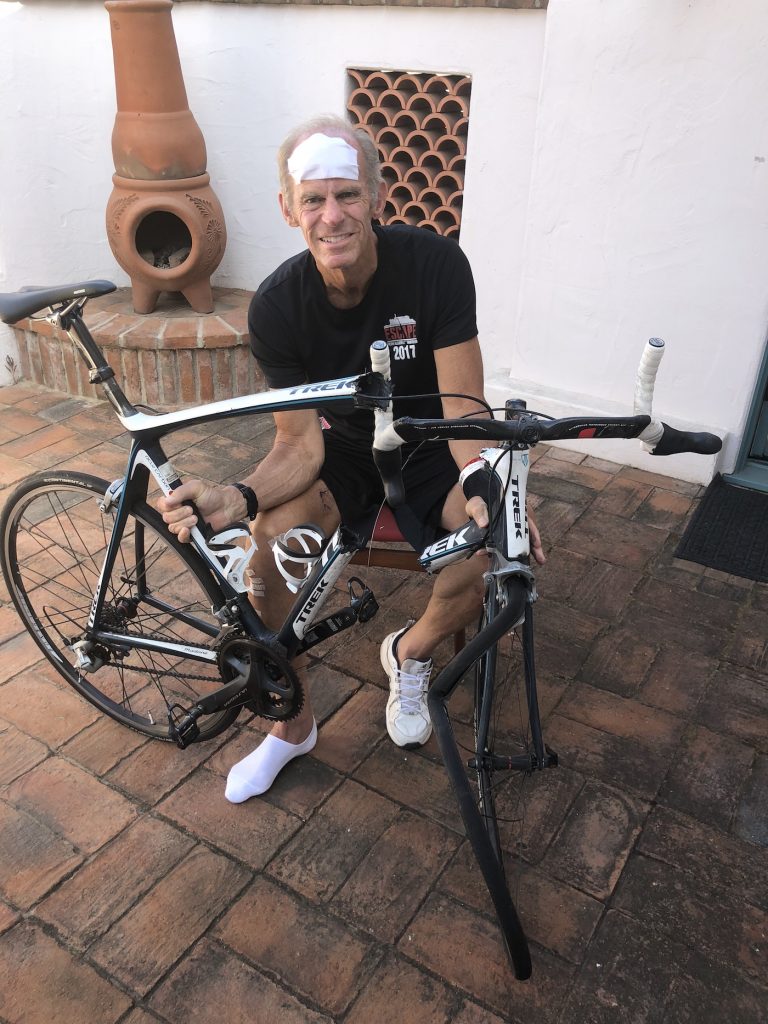Rock of Gibraltar Cyclist ‘Climbs’ back into the (bike) saddle

It was just 31 months ago that Neil Myers was nearly killed in a bike-versus-truck accident near the top of Gibraltar Road above Montecito, where the triathlete loved to train by undergoing grueling climbs up the mountain pass road. He followed the uphill treks with lightning-fast descents at speeds of more than 30 mph, far too fast to react to a truck veering into his lane, which is how he landed in the hospital on that fateful day in August 2017. Getting airlifted to the Level 1 trauma center at Cottage Hospital saved his life – Myers broke 11 bones including both wrists, one of his legs, his nose, and an astounding seven ribs as well as suffering deep lacerations and a brain bleed. Myers’ arduous path back to health – which included hurting so much at night that getting any sleep became “hand-to-hand combat” – informs Climb, the movie that Myers, a marketing company owner, also wrote and directed to document his experiences. (Be forewarned: The first still shot of his face in the hospital just shy of the six-minute mark comes as a gut punch on the screen).
The film is also a love letter to his family, the community, Santa Barbara’s beauty, his tri-team, and, not in the least, the doctors and other health professionals that enabled him to return to racing just four months after the accident. Myers shared some insights from his home office over Zoom last week.
Q. Why did you want to turn your harrowing experience and difficult recovery into a film?
A. The real question is what made me change my mind. I was vehemently against doing it at first even though I knew it was a good story. It just seemed cringe-worthy to make a movie about myself. But six months after the accident I was at the Cottage Hospital Tiara Ball where they were thanking the generous donors here in town who helped build the trauma center. They showed a five-minute promotional video of my story and I watched these people and how they were overcome realizing that something they built actually helped the community. It took me 45 minutes to get out of the building because everyone wanted to talk and tell me about how they either biked Gibraltar themselves, or how they were putting their husband’s bike on eBay the next day, or just about trauma in their lives. What I learned that night was that the story is really a fun journey for people. I was just the protagonist in what is a story about this incredible community where people show up for you when you need them.
I can’t be the only one wondering why the heck you wanted to get back on the bike and do another triathlon. Why get back on that horse again?
I hear that a lot and it surprises me because it doesn’t seem unusual to me. But that’s me. With this kind of injury your body is screaming for fuel to heal you. My nurse practitioner told me, “I don’t care how hard you’ve ever trained – you’ve never needed as much fuel as you need, right this second, right now.” But with a rib injury you can’t eat, you’re still in shock and your guts have shut down. So, your body scavenges your own body for protein and steals from your muscles. I’d had Lance Armstrong legs and one week later I had lost almost 20 pounds. I looked at myself in the mirror and thought, “I just hate this. I feel like I’ve taken a one-way trip to my 90s. I want to get back to me.” For me, the finish line was three seconds before the accident. If I could do that, I could put it behind me. And the only way I knew to do that was to go train for another race.
And then after winning in Santa Barbara, you just quit. I’m also curious how a guy as motivated as you just quit cold turkey.
That’s exactly why, because the way I’m wired. I see no way to be in a race and be able to turn off the competitive instincts, which means I’m going to take risks I don’t want to take anymore. I’ve actually ridden Gibraltar more times since the accident than before. But my role now is to not go around a turn at a speed where I can’t stop. You have to manage the risk. You have to be a glass half empty cyclist. The first time I went back up Gibraltar, I wasn’t sure I could stick to that because it is fun to go really fast. But now I love it because I can look around and enjoy the view.
And I do think I have a way to go back to competing just in Santa Barbara where the sprint route is around the cemetery, by Butterfly Beach, up to the freeway, over to Jamisen Road and then turn around and come back. It’s all flat. I could fall anywhere on that course and maybe break a leg, but it’s not going to be fatal. I’m happy doing it if I get rid of the risk.
Perhaps an obvious question: How is it now to relive what you went through on film?
I feel it intensely, but not what you might think. I don’t have fear. There’s nothing negative for me, but just seeing all the support I got breaks me down every single time. I can’t get over how lucky I was. There’s so much gratitude. That sounds like it was scripted, but that’s truly what runs through my blood.







